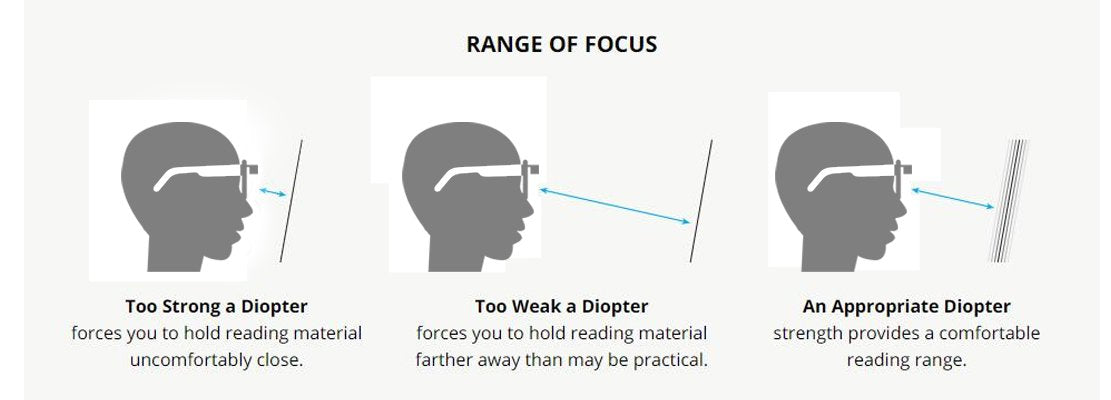How To Choose Reading Glasses?

The reading glasses are the type of glasses that add a bit more convenience for reading. Not only it helps with improving the vision but also for the people who read a lot it can protect the eyes from the strain of reading. The reading glasses are also for the people who work on the computer screens all day long. It is to protect your vision and help you to have a close-up without any difficulty. So How To Choose Reading Glasses? Before buying reading glasses we should know:
Do I Need Reading Glasses?
With increasing age just like your joints and other parts of your body, eyes do get the impact of ageing. When you will reach your 40s, it is a natural phenomenon that the natural internal lenses of the eyes become less and less flexible with the passage of time. It becomes difficult for eyes to focus easily from near to far vision as compared to the time when a person easily could when he was younger.
With decreasing flexibility in your eyes, your close vision gets worse and the difficulty to see things clearly will increase day by day. This condition is called presbyopia, and due to lack of vision, it may make you wonder if you need reading glasses.
Here are a couple of signs that will help you to decide whether you need reading glasses or not:
- When you hold reading materials such as books up close, you will find them to look blurry. You will feel like holding them farther away in order to read them clearly.
- You will face trouble seeing smaller print, especially in dim light.
- Your eyes will feel itchy or hurt when you try to read, sew or do other kinds of close work that needs precise eye attention.
- You will feel continuous headaches when you try to focus on something or you try to read.
What Strength Reading Glasses Do I Need?
This is an important thing to remember: in the case of reading glasses is, the higher the number is, the greater the power of the lenses will be. Therefore, those glasses which have a marking of 1.0 are known as low power glasses and those glasses with a marking +3.0 are known as high powered glasses.
You just need to position the eye chart at a minimum distance of approximately 14 to 16 inches from your eyes (depending on how easily you can read a normal-sized print) in order to determine the power of the required lens. It is advised that provided information should only be used as a basic guide in order to determine which level of reading glasses you require for your eyesight.
choose reading glasses strength "by age":
You may also be able to determine which strength of reading glasses you need by consulting a 'power by age table' like the one below:
- Age 40-44 – Recommended power +0.75 to +1.00 dioptre
- Age 45-49 – Recommended power +1.00 to +1.50 dioptre
- Age 50-54 – Recommended power +1.50 to +2.00 dioptre
- Age 55-59 – Recommended power +2.00 to +2.25 dioptre
- Age 61-65 – Recommended power +2.25 to +2.50 dioptre
If you find yourself torn between two sets of lenses, choose the glasses with the lower power. Opting for a pair of reading glasses that are too strong can cause discomfort compared to weaker powered glasses. This can lead to feelings of nausea and dizziness.
You might find that you require different lenses for various tasks (e.g. reading, looking at a mobile device or computer screen, etc.). If so, consider purchasing several pairs of reading glasses, each with a different strength of lens, for optimum clarity and comfort.
About Prescription Reading Glasses
One of the major drawbacks of purchasing ready-made reading glasses is that these glasses are essentially made according to specific standards that "one-size-fits-all" items. Most of the people do not contain the same prescription in both of their eyes, and almost everyone has a small amount of astigmatism correction present in their prescriptions. Therefore, customize prescription reading glasses is the best choice present out there.
It is to note that Optical Factor usually offers premium quality prescription reading glasses without including the prescription price.
How Do Reading Glasses Work?
The main purpose of reading glasses is to magnify the information, especially the smaller phones and the objects. It helps in focusing the objects and removing blurry vision. The reading glasses have become important not only for the people of age but also for the others who have continuous work in front of the computer screen. People have two types of glasses; one is to read very close while others are for mid-distance reading.
Do the reading glasses magnify?
The reading glasses definitely help in making it easier for you to read the smaller fonts and provide you with the correct diopter strength. The diopter strength is usually between + 0.75 and + 4.0. The reading glasses make it easier for you to focus by using the perfect diopter strength, which crystallizes just near the focus.
What is a diopter?
When getting the reading glasses, you might have heard about the diopter strength. But what is a diopter? Diopter is basically the formula that most Opticians used to manufacture reading glasses to provide you with the ultimate perfect focus that you need. You can think of the dioptre as a strength or the perfect spot that helps you have the Sharp Vision.
Keeping in mind that the reading material is usually kept at a 14 to 18 inches distance for reading. And the dioptre is that sweet spot that helps in reading and focusing easily. For a comfortable reading, you must get your reading glasses based on the diopter strength. However, if you are using the computer, keep in mind that you will be using the computer for at least 24 inches away. And for that, you will require weaker power reading glasses.

Should I Wear Reading Glasses All Day?
Wearing the glasses all day long depends upon the strength of the glasses. If the power of the glasses is low, then there are no worries, and you can wear them all day long; however, if the glasses' strength is stronger, you might not be able to wear them all day. However, for people with stronger and more powered reading glasses, it is highly recommended to wear them while reading and using the computer's screen and the other tasks that require high concentration. If you are planning to use the glasses all day long, you can get the bifocal glasses for progressive lenses.
Can Wearing Reading Glasses Make Eyesight Worse?
No, that is a common misconception. The weaker eyesight usually depends upon your age and your genetics, and the other activities that you perform. With prescription reading glasses, strength is measured based on the surroundings and other factors. However, if you are someone who uses the screen continuously, you must make sure that you are taking at least a 5 to 10 minutes break every one hour when using the computer screen.
Can I Get Reading Glasses With Different Strengths For Both Eyes?
Yes, that is possible. If you have different strengths for both eyes, you can always get the reading glasses with different strengths from the Optical Factor. When ordering the glasses, you just need to enter the number for the right eye and the number for the left eye of the prescription when you are checking out.
Tips for Choosing Reading Glasses
- Schedule an Eye Exam
As long as it is not an emergency, the first thing you should do is call your local eye doctor and make an appointment for a comprehensive eye examination. You are most likely experiencing symptoms of what many jokingly call the "over 40 syndrome" or "short arm syndrome." This condition is officially called presbyopia by your eye doctor. However, blurry vision can sometimes be a sign of a serious eye problem or eye disease. To be safe, schedule an eye exam to make sure your eyes are in excellent health.
- Consider Prescription Reading Glasses
One drawback to purchasing ready-made reading glasses is that they are essentially "one-size-fits-all" items. Most people do not have exactly the same prescription in both eyes, and almost everyone has at least a small amount of astigmatism correction in their prescriptions. Customize prescription reading glasses is the best choice.
- Powers in OTC readers are the same in each eye. You may need a different power for each of your eyes. Looking through readers of the wrong power can cause eye strain, making one eye work much harder than the other.
- OTC readers do not correct astigmatism; prescription readers do.1 Many people have a small amount of astigmatism. Uncorrected astigmatism can cause headaches, tired eyes, and vision that seems a little off.
- OTC readers are basically "one size fits all." Prescription reading glasses are made so that the optical center of the lens is lined up exactly at the center of the pupil. When the optical center is not lined up, you may end up looking through the side of the lens, which can cause eye strain and eye muscle imbalances.
- Prescription lenses are made optically perfect with no distortions, waves or bubbles in the lenses. If you examine a pair of OTC readers of low quality, the lenses may have some unwanted defects.
- OTC readers do not work for nearsighted people because such individuals usually require a "minus or negative" lens. OTC glasses only come in "plus or positive" powered lenses.
- Consider OTC Readers
If your eyes are such that ready-made readers will work just fine, your eye doctor will let you know. If he or she decides that they are sufficient for you, ask him what power is recommended for your eyes. Be sure to discuss your occupation and the types of hobbies you enjoy, as the power your doctor recommends may depend on what type of work you do.
For example, the power prescribed for you if you spend eight hours a day on the computer will likely be different than one prescribed for you if you spend a lot of time reading or working with fine detail.
Face shape is a problem that cannot be ignored.
To find out the perfect reading glasses for yourself, read on to find out how you can choose a reading glasses:

- If you've got an oval face, you're in luck! It's by far the "perfect" face shape out there and just about any style, shape and size suits you! So what are you waiting for? Go flaunt those new shades!
- Having a round face means that the shape of the sunglass has to be such that it makes your face look chiseled and longish, but cutting down those chubby cheeks. Rectangular frames, especially those that are slightly broader than your face will suit you best.
- An angular face needs a pair of shades that'll make your features tone down and get you that soft, sophisticated look. When choosing sunglasses, you can either opt for square frames, or frames that are smaller than your face so that it minimizes your curves.
- If you have a square face, the frames that would look absolutely perfect are cat's eye frames. They add a style quotient to square faces and at the same time minimize the squareness of your face, adding volume.
- For an oblong face, it would be best if you settle for round or square shaped frames. This would shorten the length of your face, giving it an illusion of being broader than it really is.
- For those who have a heart shaped face, go for cat's eye rimmed glasses that enhance the area around the eye, rimless glasses look fabulous as well.
About Lenses
Single Vision Lenses

Pros
- Most affordable lens type.
- Used to correct nearsightedness and farsightedness.
- Typically no adjustment period needed to get used to.
Cons
- Correction for only one vision depth, Either near or far.
- Costs can rise surprisingly high depending on lens material & prescription strength.
Best For
- Nearly anyone under the age of 40.
- Those only needing to correct nearsighted or farsighted vision.
- Ordinary over-the-counter reading glasses.
Bifocal Lenses

Pros
- The 2-in-1 lens provides both close-up & distance vision correction.
- Cost effective solution for multiple vision depths.
- Relatively cheap, especially compared to progressive lenses.
Cons
- Distinct, non-discrete line & half circle shaped near vision lens.
- Image jump when transitioning from distance to near vision & back again.
Best For
- Anyone already wearing glasses & needing reading glasses as well.
- Those that want vision correction for multiple depths at a reasonable price.
- Someone who requires reading glasses but doesn’t want to purchase & carry a second pair.
Progressive Lenses

Pros
- The 3-in-1 lens provides near, mid, and long distance vision correction.
- Eliminate the need to switch between multiple pairs of glasses.
- No visible lines on the lens for a seamless transition between the 3 zones.
Cons
- Adjustment period needed to train yourself on using the three different vision areas.
- New users can feel dizzy or nauseous until they get used to them.
- Considerably more expensive than single vision or even bifocal lenses.
Best For
- Anyone that desires discrete vision correction for distance, near, and everything in between.
- Those that want a seamless transition, no visible lines in the lens.
- Someone who requires reading glasses but doesn’t want to purchase & carry a second pair.
------------------------------------------------
You have a wide variety of choices when it comes to reading glasses! You can also choose prescription reading glasses. Prescription reading glasses are meant to be and usually worn for a long time of period. They are ideal for those people which have astigmatism, myopia, some serious eye disorders or have unequal prescription strength in each of the eyes. Maybe you are worried that buying reading glasses may cost too much, Optical Factor will help you. Optical Factor offers you the perfect deals specifically customized for our customers on various eye wear options with incredible prices.





